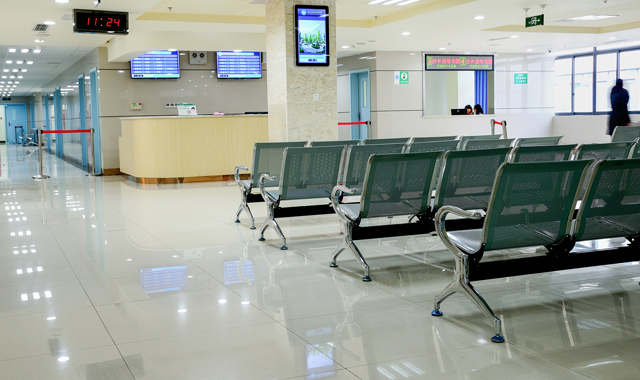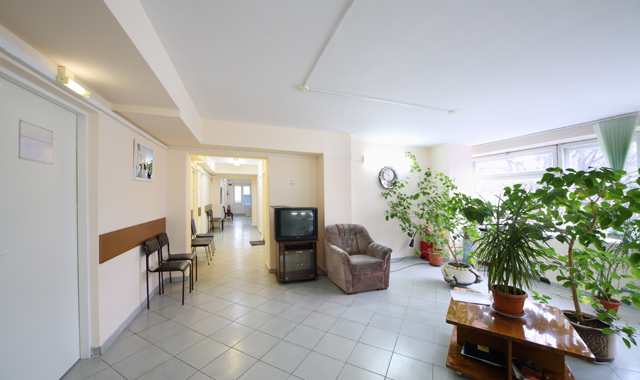
- Homeowners
- Professionals
- Products
- Back
- PlasterBoards
- Metal Framing & Accessories
- Jointing and Finishing
- Gypsum Plasters
- Ceiling Tiles
By material Type
By Category
- Resources
- About
- Careers
- FAQ's
Good Design can reduce anxiety, Lower blood pressure, improve the post-operative course, reduce the need for pain medication and shorten the hospital stay.

Research reveals that indoor air is often more polluted than outdoor air, a particularly threatening issue within healthcare settings.
Harmful volatile organic compounds (VOCs) can be inhaled, affecting patients’ invariably weakened immune systems. In fact, nearly 50% of respiratory illnesses, including asthma, are caused or aggravated by poor indoor air because airborne formaldehyde (a common VOC) acts as an irritant to the conjunctiva and upper and lower respiratory tracts.
Our plasterboards do not contain any hazardous substances and Gyproc® drywall systems can be specified with Activ’Air® cleaning features to ensure a lower formaldehyde level, which can greatly enhance the overall patient experience.
Healthcare facilities are often large expansive buildings containing many people with differing levels of mobility.
Thus, in the unlikely event of a fire, it is imperative that passive fire protection is designed into the building fabric in order to contain the fire in manageable compartments and prevent it from spreading. It is equally important to provide extra fire protection to corridors, stairwells and other escape routes to ensure that people can evacuate the building safely and that firefighters can do their job effectively.
The spread of fire within a building can be restricted by sub dividing it into compartments separated from one another by walls and/or floors of fire resisting construction.
The objectives are two fold:
Gyproc® Drywalls serves the need for compartmentation thereby providing effective passive fire protection
Most areas within healthcare buildings, due to their very nature, are subject to intensive use which can result in significant damage to interiors. Unplanned maintenance in healthcare building can be disruptive to critical areas in the premise.
Hospital facilities are subject to major movement of people and of all sorts of equipment: stretchers, beds, wheelchairs, trolleys etc. This repeated circulation may lead to physical damage and leave visible impact on the walls of corridors and rooms. Hence, choice of durable material in designing internal areas has a significant impact on overall cost and it also leads to more predictable maintenance cycles
Gyproc® Drywalls provide strong robustness supported by Duraline Boards that cater to the need of Impact resistance in hospitals.
Patients require a peaceful atmosphere to support their physiological and psychological well-being and recovery. Medical staff are also more effective in calm conditions. Yet the constant beeping of medical equipment, alarms, telephones, and trolley and bed movements compounded by visitor interaction and staff conversations, mean that hospital environments are naturally noisy.
One study concluded that prolonged exposure to low frequency noise, such as the rumble of HVAC equipment, can raise blood pressure and stress levels and cause headaches and respiratory ailments. 58% of ICU patients rate a noisy environment as the second most frequent source of sleep disturbance, which, along with the resulting lack of rest, may have various physiological consequences on the respiratory, cardiovascular and immunological systems. Continuous high noise may impact the duration of wound healing and therefore the time patients are hospitalised.
Designers can use HTM 56 for selecting level of sound insulation required between adjacent spaces.
Using the principles outlined in HTM 56 following are the considerations for the relevant areas:
The matrix of activity spaces in following Table has been compiled to assist the design team in determining a suitable sound insulation grade for some common partition situations in Healthcare areas. These relate only to the partition between any two adjacent spaces.
Patient healing demands an aesthetically appealing and relaxing surroundings. Hospitals distinguish themselves by their unique aesthetics. Finishes therefore, are a key design consideration. Hospitals need finishing options like wall paints, wall papers, wall panels, tiles, niche walls and corners, cladding of mirrors.
Our Gyproc® plasterboards guarantee freedom in design and provide seamless and crack-free surfaces of the highest smoothness
Every single component that goes into making a building, from the life cycle of the raw materials to its structural design, significantly impacts the well-being of its occupants and the immediate environment.
As a conscientious manufacturer of gypsum solutions, we share the responsibility to help you make a sustainable difference when selecting products and systems for constructing healthcare facilities.
Our plasterboard is 100% recyclable into new plasterboard or soil conditioner. The installation of Gyproc® systems uses less water when compared to traditional brick and block construction
GYPSUM DRYWALLS HELP OPTIMISE PROJECT COSTS
India has only 1.3 hospital beds per 1,000 people-significantly lower than the guideline of 3.5 beds defined by World Health Organisation. One of the means to address this demand- supply gap is increase in the number of beds as close as possible to match the growth in population. This is one area where a shift to construction materials that facilitate faster construction will play a pivotal role.
Gyproc® drywall technology is a proven and preferred technology used worldwide by the healthcare industry to aid faster construction resulting in faster opening of hospital. Due to faster installation, faster completion (3 to 4 times faster than brick/block technology) and structural savings, Gyproc® drywall systems lead to significant savings in total project costs when compared to traditional bricks and blocks leading to faster opening of hospitals.
See the full details about drywall advantages compared to traditional methods and read about real-life Total Installed Cost savings case studies below:
Gyproc® Solutions for HEALTHCARE SECTOR
Gyproc® false ceiling and drywalls are used worldwide by the healthcare industry to deliver high performance hospitals as per globally recognized standards. Gyproc® offers drywall solutions for every area and application in a hospital.
know more

HEALTHCARE
Project References